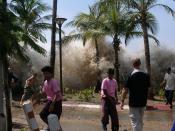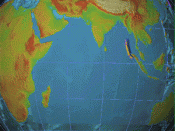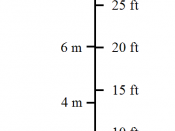Fires and I hadn't really been the best of friends. My worst experience would be when I burnt my hand with a fire cracker at about the age of eight. Six years later a disaster that affected people globally reminded me that I live in one of the world's (very) hot spots. We live atop the rings of fire. Indonesia has gone through numerous eruptions but we are still pretty blase about the fact that we are standing on hot lava oozing along the earth's cracked crust otherwise known as tectonic plates.
On the 26th of December 2004, whilst most of us were unwrapping our Christmas surprises, people in parts of south East Asia had a very unwanted surprise. An earthquake that measured 8 on the Richter scale was an abrupt wake up call to everyone. The epicenter of the earthquake was nearest to Aceh, a populated city in the island of Sumatra, Indonesia.
The giant tsunami that followed was described as a nightmare come true. It literally swallowed the city and everyone was engulfed. Fortunately, in the middle of all that devastation, help was pouring in, the effort was inspiring as the people around me, including myself, decided to contribute to the tsunami aid. The destruction was unquestionably eye-opening and although I had learnt about tsunamis before, (from Japanese-paintings of gigantic curling waves and The Day After Tomorrow- a movie that visualized a tsunami swallowing the whole of Manhattan-) it still didn't prepare me for the damage it had caused to a place that is so close to where I live. The experience had the people of Indonesia grieving, the people of Sumatra very jittery; and as quoted in the Jakarta Post,
Just imagine... One child points to a dark cloud and everyone's shouting 'It's Doomsday!'
Doomsday indeed.
Sadly, Indonesia has had other days that were just as fair-laden. An eruption in 1815 in Tambora, Indonesia was crowned the largest volcanic eruption in history.
[It] was sometimes called 'eighteen hundred and froze to death' because of extraordinary weather changes, including snow falling in mid-summer.
The eruption triggered a tsunami which killed 90,000 people. (Compare this with the tsunami in 2004 which killed 80,000 people in Aceh alone. This pushed the numbers to more than 120,000 victims around South East Asia.) This eruption must have been a mind-blowing experience. The tsunami in Aceh was undoubtedly destructive but it didn't create significant changes to the weather such as the Tambora eruption. People foresee the 2004 tsunami as the beginning to the end of the world, as if nothing as big as this had happened in Indonesia. Ironically, people are still living and developing in disaster-prone areas, falsely hoping the earth will remain dormant. It might be the lack of geographical knowledge that people had a century ago, or are they just too stubborn to leave the earth alone? After such a wide destruction like the Tambora eruption or the Aceh Tsunami, I would think the people of Indonesia need not another abrupt reminder. Unfortunately, this was proved wrong when another tsunami followed in 1833 following the eruption of Krakatoa, Indonesia and this time 36, 400 people were killed. The giant wave was known to raise water levels as far away as France! An eleventh-century document written by a sixth-century historian described an early eruption of Krakatoa...
Everyone declared that the sun would never recover its full light again. The fruits did not ripen, the wine tasted like sour grapes.
Imagine what a child would say, waking up to a day where the sunshine wasn't nearly as bright as yesterday. If a child after the 2004 tsunami pointed to a dark cloud and exclaimed that its doomsday, what kind of doom was the 1833 Krakatoa eruption? The explosion created so much debris that it sent fiery sunsets all over the world for the next year. From the book, Krakatoa: The Day The World Exploded ;
The eruption of Krakatoa was also one of the first major events in the colonial world to be reported back to Europe by way of newly laid undersea telegraph cables, and so became an early symbol of the global scope of information and interdependence that would come to characterize the modern era.
It is interesting how nearly two centuries ago, a huge explosion symbolized modernization, whereas a disaster in the modern era, 2004, symbolized the declining of the world, as if the world is trying to renew itself!
For people like me who live in the densely populated capital city of Jakarta, earth quakes are quite rare and if they do occur they are mostly tremors. However, the boxing day tsunami greatly affected people not only in Aceh and around Indonesia but also all over the world. The fear and awareness lasted for a few months and although people are still grieving the people of Indonesia in general aren't very aware of its geographical location. I don't think the fact that we have some of the world's most historical volcanoes here at home has really come across. The climax of the destruction is always overwhelming and it might seem impossible to over-react but it is not just the immediate action that we should think about, safety precautions are very important as well. As for me, I'm not traumatized by fireworks and such but I would never try to light another fire cracker again. Although the rings of fire have caused far worse things than the scarring of my hand, I think we should have that kind of mentality; fire won't hurt you if you don't play with fire!


